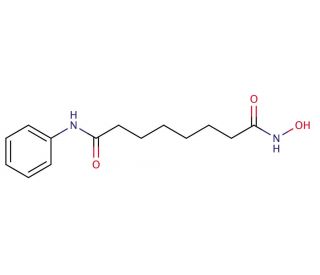
Click on image or enlarge button to enlarge



Suberoylanilide Hydroxamic Acid: sc-220139
Suberoylanilide Hydroxamic Acid (CAS 149647-78-9)
See product citations (36)
Alternate Names:
Vorinostat
Application:
Suberoylanilide Hydroxamic Acid is a potent HDAC inhibitor; also causes cell cycle arrest at G1
CAS Number:
149647-78-9
Purity:
≥99%
Molecular Weight:
264.32
Molecular Formula:
C14H20N2O3
For Research Use Only. Not Intended for Diagnostic or Therapeutic Use.
* Refer to Certificate of Analysis for lot specific data.
QUICK LINKS
Ordering Information
Product Citations
Description
Technical Information
Safety Information
SDS & Certificate of Analysis
Suberoylanilide Hydroxamic Acid (SAHA) is a potent histone deacetylase (HDAC) inhibitor that has been shown to inhibit proliferation and cause cell cycle arrest at G1. Experiments suggest that SAHA also causes morphological changes, such as enlargement and flattening of the cytoplasm, resulting in growth inhibition. Treatment of cells with SAHA also decreases the expression of anti-apoptosis proteins Bcl-xL and survivin.
References:
- The histone deacetylase inhibitor suberoylanilide hydroxamic acid induces differentiation of human breast cancer cells. | Munster, PN., et al. 2001. Cancer Res. 61: 8492-7. PMID: 11731433
- Zn(II)-dependent histone deacetylase inhibitors: suberoylanilide hydroxamic acid and trichostatin A. | Codd, R., et al. 2009. Int J Biochem Cell Biol. 41: 736-9. PMID: 18725319
- Lysine acetylation targets protein complexes and co-regulates major cellular functions. | Choudhary, C., et al. 2009. Science. 325: 834-40. PMID: 19608861
- Suberoylanilide hydroxamic acid sensitizes human oral cancer cells to TRAIL-induced apoptosis through increase DR5 expression. | Yeh, CC., et al. 2009. Mol Cancer Ther. 8: 2718-25. PMID: 19737941
- Suberoylanilide hydroxamic acid induces apoptosis and sub-G1 arrest of 320 HSR colon cancer cells. | Sun, PC., et al. 2010. J Biomed Sci. 17: 76. PMID: 20846458
- Suberoylanilide Hydroxamic Acid Alleviates Acute Lung Injury Induced by Severe Hemorrhagic Shock and Resuscitation in Rats. | Li, W., et al. 2020. Shock. 54: 474-481. PMID: 31895876
- Suberoylanilide hydroxamic acid attenuates epidural fibrosis via inhibiting myofibroblast differentiation and increasing fibroblast apoptosis. | Yang, JS., et al. 2020. Eur Rev Med Pharmacol Sci. 24: 5726-5733. PMID: 32495908
- Suberoylanilide hydroxamic acid enhances the radiosensitivity of lung cancer cells through acetylated wild-type and mutant p53-dependent modulation of mitochondrial apoptosis. | Wu, K., et al. 2021. J Int Med Res. 49: 300060520981545. PMID: 33557658
- Suberoylanilide Hydroxamic Acid (SAHA) Reduces Fibrosis Markers and Deactivates Human Stellate Cells via the Epithelial-Mesenchymal Transition (EMT). | Özel, M., et al. 2021. Cell Biochem Biophys. 79: 349-357. PMID: 33689126
- Heparin-binding growth factor isolated from human prostatic extracts. | Mydlo, JH., et al. 1988. Prostate. 12: 343-55. PMID: 3393496
- Suberoylanilide hydroxamic acid (SAHA) inhibits transforming growth factor-beta 2-induced increases in aqueous humor outflow resistance. | Fujimoto, T., et al. 2021. J Biol Chem. 297: 101070. PMID: 34389355
- Novel Suberoylanilide Hydroxamic Acid Analogs Inhibit Angiogenesis and Induce Apoptosis in Breast Cancer Cells. | Moku, G., et al. 2022. Anticancer Agents Med Chem. 22: 914-925. PMID: 34488592
- Suberoylanilide hydroxamic acid suppresses axonal damage and neurological dysfunction after subarachnoid hemorrhage via the HDAC1/HSP70/TDP-43 axis. | Luo, K., et al. 2022. Exp Mol Med. 54: 1423-1433. PMID: 35501375
Ordering Information
| Product Name | Catalog # | UNIT | Price | Qty | FAVORITES | |
Suberoylanilide Hydroxamic Acid, 100 mg | sc-220139 | 100 mg | $115.00 | |||
Suberoylanilide Hydroxamic Acid, 500 mg | sc-220139A | 500 mg | $220.00 |